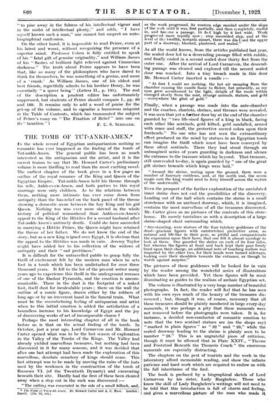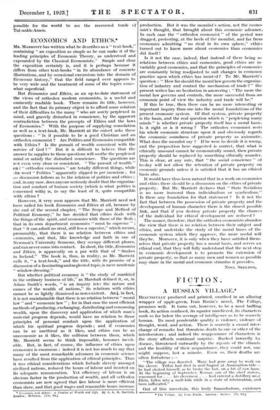THE TOMB OF TUT-ANKH-AMEN.*
Ix the whole record of Egyptian antiquarianism nothing so romantic has ever happened as the finding of the tomb of Tut-ankh-Amen. The general public has been as much interested as the antiquarian and the artist, and it is the merest truism to say that Mr. Howard Carter's preliminary volume is more thrilling to read than the most exciting novel. The earliest chapter of the book gives in a few pages an outline of the royal romance of the King and Queen of the Egyptian Empire. Tut-ankh-Amen held his throne through his wife, Ankh-es-en-Amen, and both parties to this royal marriage were only children. As to the relations between them, nothing more intimate has ever come down from antiquity than the bas-relief on the back panel of the throne showing a domestic scene between the boy King and his girl Queen. Nothing too was ever more shrewd in the whole history of political womanhood than Ankh-es-en-Amen's appeal to the King of the Hittites for a second husband after Tut-ankh-Amen's untimely death. Could she have succeeded in marrying a Hittite Prince, the Queen might have retained the throne of her father. We do not know the end of the story, but as a new king reigned over Egypt, it is obvious that the appeal to the Hittites was made in vain. Jeremy Taylor might have added her to his collection of the widows of antiquity and their " sad prettiness."
It is difficult for the untravelled public to grasp fully the thrill of excitement felt by the modern man when he sets foot in a tomb which has been undisturbed for over three thousand years. It fell to the lot of the present writer many years sgo to experience this thrill in the underground recesses of one of the Dashur Pyramids, and the emotion is uncom- municable. There in the dust is the footprint of a naked foot, itself dust for incalculable years ; there on the wall the outline of a comic figure, drawn either by the robbers of long ago or by an irreverent hand in the funeral train. What must be the overwhelming feeling of antiquarian and artist when to this initial emotion is added the satisfaction of a boundless increase to his knowledge of Egypt and the joy of discovering works of art of incomparable charm ?
Perhaps the most interesting chapter of all in the book before us is that on the actual finding of the tomb. In October, just a year ago, Lord Carnarvon and Mr. Howard Carter opened what was to be the last season of exploration in the Valley of the Tombs of the Kings. The Valley had already yielded marvellous treasures, but nothing had been discovered in it for many seasons, and it was decided that after one last attempt had been made the exploration of this marvellous, desolate cemetery of kings should cease. This last attempt was to be made by moving the ruins of the huts used by the workmen in the construction of the tomb of Rameses VI. (of the Twentieth Dynasty) and excavating beneath their site. Hardly had the first of these been cleared away when a step cut in the rock was discovered :- " The cutting, was excavated in the side of a small hillock, and, • The Tomb of Tuf-ankh-Amen. Bs Howard Carter and A. C. Mace. London : Cassell, 1.31s. Od, set.] as the work progressed, its western edge receded under the slope of the rc-ek until it was, first partially, and then completely, roofed in, and bee une a passage, 10 feet high by 6 feet wide. Work progresf ed more rapidly now ; step succeeded step, and at the level of tha twelfth, toWgirds sunset, there was distl-sed the upper part of a doorway, blocked, plastered, and sealed."
As all the world knows, from the articles published last year, the sealed door led to a descending passage filled with rubble, and finally ended in a second sealed door thirty feet from the outer one. After the arrival of Lord Carnarvon, the descend- ing passage was cleared and explored till the second sealed door was reached. Into a tiny breach made in this door Mr. Howard Carter inserted a candle :— " At first I could see nothing, the hot air escaping from the chamber causing the candle flame to flicker, but presently, as my eyes grew accustomed to the light, details of the room within emerged slowly from the mist, strange animals, statues, and gold —everywhere the glint of gold."
Finally, when a passage was made into the ante-chamber and the couches, chariots, shrines, and thrones were revealed, it was seen that yet a further door lay at the end of the chamber guarded by " two life-sized figures of a king in black, facing each other like sentinels, gold kilted, gold sandalled, armed with mace and staff, the protective sacred cobra upon their foreheads." No one who has not seen the extraordinary effect produced on the mind by statues in an Egyptian tomb can imagine the thrill which must have been conveyed by these silent sentinels. There they had stood through an unimagined series of years guarding in darkness and silence the entrance to the treasure which lay beyond. That treasure, still unrevealed to-day, is again guarded by " one of the great gilt shrines beneath which kings were laid."
" Around the shrine, resting upon the ground, there were a number of funerary emblems, and, at the north end, the seven magic oars the king would need to ferry himself across the waters of the underworld. '
Even the prospect of the further exploration of the unviolated inner shrine does not end the possibilities of the discovery. Leading out of the hall which contains the shrine is a small storehouse with an unclosed doorway, which, it is imagined, contains the most marvellous of all the treasures discovered. Mr. Carter gives us no pictures of the contents of this store- house. He merely tantalizes us with a description of a large shrine-shaped chest surrounding which,
" free-standing, were statues of the four tutelary goddesses of the dead—gracious figures with outstretched protective arms, so natural and life-like in their pose, so pitiful and compassionate the expression upon their faces, that one felt it almost sacrilege to look at them. One guarded the shrine on each of its four sides, but whereas the figures at front and back kept their gaze firmly fixed upon their charge, an additional note of touching realism was imparted by the other two, for their heads were turned sideways, looking over their shoulders towards the extrance, as though to watch against surprise."
The pictures of these goddesses will be looked for in vain by the reader among the wonderful series of illustrations which have been provided. Yet these figures will be most illuminating as guides to the realism of archaic Egyptian art.
The volume is illustrated by a very large number of beautiful photographs. In fact, the reader will feel that he has seen with his own eyes much of the beauty of the treasures dis- covered ; but, though it was, of course, necessary that all these treasures should be plainly numbered in large every-day numerals, it was perhaps a pity that these numerals were not removed before the photographs were taken. It is, for instance, a decided non-conductor of romantic emotion to note that the two sentinel statues are (as the shops say) " marked in plain figures " as " 22 " and " 29," while the sealed doorway leading to the shrine is plainly seen to be number " 28." This is an ungrateful piece of criticism, though it must be allowed that in Plate XXIV., " Throne and Footstool Beneath the Thoueris Couch " the enormous numerals are especially distracting.
The chapters on the pest of tourists and the work in the laboratory afford memorable reading, and show the infinite patience and hard work which are required to endow us with the full inheritance of the find.
The book is prefaced by a biographical sketch of Lord Carnarvon by his sister, Lady Burghclere. Those who know the skill of Lady Burghclere's writings will not need to be told that this introduction is full of charm and feeling, and gives a marvellous picture of the man who made it possible for the world to see the recovered tomb of Tut-ankh-Amen.



























































 Previous page
Previous page